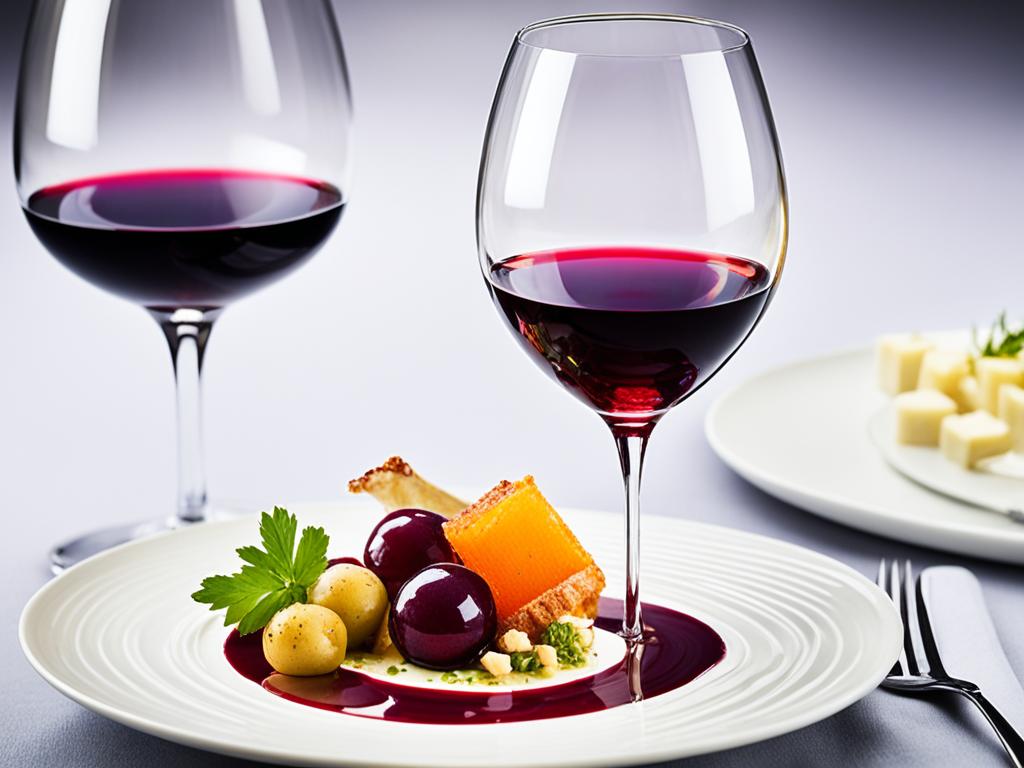Welcome to our comprehensive guide on the art of pairing food and wine! Are you ready to elevate your meals and take your dining experience to the next level? By delving into the world of food and wine pairing, you can unlock a whole new realm of flavors and sensations. Whether you’re a seasoned sommelier or a wine enthusiast looking to enhance your culinary adventures, we’ve got you covered. Let’s dive in and discover the perfect harmony of flavors that await you!
Key Takeaways:
- Pairing food and wine is an art form that can greatly enhance your dining experience.
- Understanding the basics of food and wine pairing is essential to creating successful combinations.
- Seafood dishes require special attention when it comes to wine pairing due to their delicate flavors.
- Vegetarian cuisine offers a wide range of flavors, making it an exciting challenge for wine pairing.
- When it comes to desserts, finding the perfect balance between sweetness and wine flavors is key.
The Basics of Pairing Food and Wine
Before diving into specific pairings, it’s important to understand the fundamentals of food and wine pairing. By following a few key principles and considering various factors, you can create successful combinations that enhance your dining experience.
Principle 1: Match Intensity
When pairing food and wine, it’s crucial to consider the intensity of flavors. A general rule of thumb is to pair light dishes with lighter wines, such as Sauvignon Blanc or Pinot Grigio, and robust dishes with bolder wines, like Cabernet Sauvignon or Shiraz. This ensures a harmonious balance of flavors that complement each other.
Principle 2: Consider Flavors
The flavors of both the food and the wine should be considered when selecting a pairing. For example, a citrusy Chardonnay can pair beautifully with seafood dishes, while a spicy Zinfandel can enhance the flavors of rich, savory meats. Look for complementary flavor profiles that enhance and elevate the overall taste experience.
| Food | Wine |
|---|---|
| Grilled chicken | Chardonnay |
| Salmon | Pinot Noir |
| Beef steak | Malbec |
Principle 3: Consider Texture
The texture of the food and the wine should also be taken into account. For example, a creamy pasta dish pairs well with a buttery Chardonnay, while a light, crispy salad is complemented by a refreshing Sauvignon Blanc. Consider how the textures of the food and wine interact to create a balanced and enjoyable combination.
When it comes to food and wine pairing, there are no hard and fast rules. The most important thing is to trust your own palate and experiment with different combinations to find what works best for you.
By understanding the basics of pairing food and wine, you can create memorable dining experiences that delight your taste buds. As you continue exploring the world of food and wine pairings, remember to appreciate the unique characteristics of each dish and bottle, and embrace the endless possibilities that this artful combination offers.
Seafood and Wine: A Delicate Balance
When it comes to pairing food and wine, seafood dishes require special attention and consideration. Achieving a harmonious blend of flavors between the delicate nature of seafood and the complexity of wine is a true art. It is essential to find the right balance that elevates both elements, creating an unforgettable dining experience.
Matching wine with various types of seafood involves taking into account several factors, such as texture, flavor profiles, and cooking methods. These aspects influence the overall taste sensation and can make or break the pairing.
The Influence of Texture
The texture of seafood plays a significant role in determining the ideal wine pairing. Light, delicate seafood, such as oysters and flaky white fish, pairs well with crisp white wines, such as Sauvignon Blanc or Chardonnay, as they complement the subtle flavors and delicate textures. The acidity and freshness of these wines cleanse the palate and enhance the seafood’s natural flavors.
On the other hand, richer and more robust seafood, like grilled salmon or lobster, can handle fuller-bodied white wines or even light reds. The intensity of these wines matches the boldness of the flavors, adding depth and complexity to the pairing.
Flavor Profiles and Cooking Methods
The flavor profiles of both the seafood and the wine must be taken into consideration to achieve a perfect pairing. Light and citrusy seafood dishes, such as ceviche or grilled shrimp, beautifully complement aromatic white wines like Riesling or Pinot Grigio. The fruity and vibrant notes of these wines enhance the freshness and zestiness of the seafood.
When it comes to more savory seafood preparations, such as garlic butter prawns or seafood pasta, consider pairing them with fuller-bodied white wines or light reds. Chardonnay or Pinot Noir can provide the necessary richness and structure to match the bold flavors of the dish.
“The art of pairing seafood and wine lies in finding a delicate balance of flavors, textures, and aromas. By understanding how these elements interact, you can elevate your seafood dishes and create an unforgettable dining experience.” – Wine Expert
Exploring the Possibilities
In the vast world of seafood and wine pairing, there are endless opportunities to explore and discover new combinations. Don’t be afraid to experiment with different varietals and regions. For example, try pairing sushi or sashimi with a crisp and mineral-driven Sancerre from the Loire Valley or a dry Riesling from Germany.
Remember, the key is to find a balance that enhances both the seafood and the wine. Each pairing is an opportunity to create a magical harmony of flavors that leaves a lasting impression on your taste buds.
Illustrative Image: A visual representation of perfectly plated seafood accompanied by a glass of elegant white wine. The image showcases the delicate balance between the two elements, capturing the essence of seafood and wine pairing.
Vegetarian Dishes and Wine Pairing
Vegetarian cuisine offers a wide range of flavors and textures, making it an exciting challenge for wine pairing. Whether you’re indulging in a light salad or enjoying a hearty plant-based meal, finding the perfect wine selection can truly elevate your dining experience.
When it comes to vegetarian dishes, the key is to consider the flavors and ingredients in the recipe. Vegetables often have distinct characteristics that can impact the choice of wine pairing. Earthy flavors found in root vegetables, such as beets and carrots, pair well with medium-bodied red wines like Pinot Noir or Merlot. On the other hand, crisp and acidic white wines like Sauvignon Blanc or Chardonnay can complement the fresh flavors of salads and light vegetable dishes.
When you’re cooking with more intense flavors such as mushrooms or spices, consider wines with bolder characteristics to match the complexity. A robust red wine like Cabernet Sauvignon or a rich and aromatic Gewürztraminer can beautifully balance and enhance the flavors in these dishes.
Remember, the key to successful vegetarian dish and wine pairing is balance and harmony. Consider the intensity of both the dish and the wine, ensuring they complement each other rather than overpowering one another.
Exploring Unique Pairings
Vegetarian cuisine allows for creativity and experimentation, giving you the opportunity to discover unique flavor combinations. Here are a few ideas to inspire your vegetarian dish and wine pairings:
- For a vibrant and zesty summer salad, try pairing it with a refreshing Riesling or a crisp Rosé. The fruity notes and acidity in these wines can bring out the freshness of the ingredients.
- When indulging in rich and creamy pasta dishes, opt for a full-bodied white wine like an oaked Chardonnay or a buttery Viognier. These wines can complement the richness of the sauce and add depth to the overall flavor profile.
- If you’re enjoying a hearty vegetable curry with bold spices, consider a fruity and aromatic red wine like a Syrah or a Grenache. The spice notes in the wine can harmonize with the flavors of the curry, creating a truly delightful pairing.
Remember, these suggestions serve as a starting point, and there are countless wine options to explore when it comes to vegetarian dishes. Don’t be afraid to experiment and try new combinations to find your personal favorite pairings.
The Perfect Pairing: Vegetarian Pizza and Sangiovese
One classic vegetarian dish that deserves a special mention is the beloved vegetarian pizza. With its medley of flavors, from tangy tomato sauce to a variety of vegetables and herbs, it calls for a wine that can stand up to its complexity. The perfect match for a vegetarian pizza is Sangiovese, a red wine with medium body and bright acidity.
The earthy and fruity notes of Sangiovese beautifully complement the savory and herbaceous flavors found in the pizza. The wine’s acidity refreshes the palate and cuts through the richness of the cheese, creating a harmonious and satisfying pairing.
So, the next time you’re enjoying a vegetarian feast, don’t forget to consider the wine that will take your experience to the next level. Cheers to the endless possibilities of vegetarian dishes and wine pairing!
Desserts and Sweet Wines: A Perfect Ending
Desserts are the crowning glory of any meal, indulging your sweet tooth and satisfying your cravings. But finding the perfect wine to accompany these delectable treats can be a challenge. The key lies in striking a balance between the sweetness of the dessert and the flavors of the wine. Let’s dive into the world of sweet wines and discover how they can create a perfect ending to your dining experience.
When it comes to pairing desserts with wine, it’s important to consider the level of sweetness. A dessert that is too sweet can overpower a wine, while a wine that is not sweet enough can taste harsh and acidic. Therefore, the key is to find wines that match the intensity of the dessert’s sweetness, creating a harmonious and enjoyable pairing.
One classic example of a perfect pairing is pairing a rich chocolate dessert with a luscious Port wine. The velvety texture and intense flavors of the chocolate are beautifully complemented by the sweet and fortified nature of Port. It’s a match made in dessert heaven.
Exploring Sweet Wine Varieties
There are various types of sweet wines that can elevate your dessert experience:
- Late Harvest Wines: These wines are made from grapes that have been left on the vine longer to develop higher sugar levels. Late harvest Rieslings or Gewürztraminers are excellent options for pairing with fruit-based desserts, as their natural acidity helps balance the sweetness.
- Ice Wines: Produced from grapes that have been naturally frozen on the vine, ice wines offer concentrated sweetness and vibrant flavors. They are a wonderful choice for pairing with desserts featuring tropical fruits or creamy textures.
- Moscato: Known for its natural sweetness and aromatic qualities, Moscato wines are perfect for pairing with light, fruit-focused desserts. The effervescence and floral notes of Moscato create a delightful contrast with the sweetness of the dessert.
Remember, personal preference plays a key role in wine pairing. Don’t be afraid to experiment and try different combinations to find your own perfect pairing. A sweet wine can add a touch of elegance and sophistication to any dessert, providing a memorable and satisfying conclusion to your meal.
Quotable Moments
“Pairing a dessert with the perfect sweet wine is like creating a beautiful symphony of flavors. It’s all about finding that delicate balance and making every bite and sip a memorable experience.” – Master Sommelier Andrea Robinson
Global Cuisine: Wine Pairing Palate
When it comes to exploring the rich diversity of global cuisine, the possibilities for wine pairing are endless. Each region offers unique flavors, spices, and cooking techniques that can elevate your dining experience to new heights. Whether you’re indulging in Italian pasta, Japanese sushi, or Indian curry, the right wine can enhance the flavors and create a harmonious balance on your palate.
Let’s dive into the art of pairing global cuisine with the perfect wine. Whether you’re an adventurous food lover or a seasoned wine connoisseur, these tips will help you navigate the world of flavors and make informed choices.
Italian Cuisine: A Symphony of Flavors
Italian food is renowned for its wide range of flavors and textures. From rich tomato-based sauces to delicate seafood dishes, Italian cuisine offers a little something for everyone. When it comes to wine pairing, traditional Italian wines like Chianti, Barolo, and Pinot Grigio are excellent choices. Their acidity and complexity complement the intricate flavors of Italian dishes, providing a delightful dining experience.
Asian Cuisine: A Fusion of Aromas
Asian cuisine is a tapestry of vibrant flavors and aromatic spices. From the umami-filled dishes of Japan to the fiery curries of Thailand, the complex flavors can be challenging to pair with wine. However, there are some standout choices that can elevate your Asian dining experience. Riesling, Gewürztraminer, and sparkling wines like Prosecco are excellent options. Their refreshing acidity and fruity notes complement the bold flavors of Asian dishes, creating a harmonious balance on your palate.
Mexican Cuisine: A Fiesta of Spices
Colorful, spicy, and loaded with flavor, Mexican cuisine is a fiesta for your taste buds. From tangy salsas to succulent grilled meats, Mexican dishes offer a wide range of taste experiences. To complement these lively flavors, opt for wines with bold fruit flavors and a touch of sweetness. Cabernet Sauvignon, Zinfandel, and Malbec are excellent choices that can stand up to the robust spices and bring out the best in Mexican cuisine.
Conclusion
In conclusion, the art of pairing food and wine is a delightful way to enhance your dining experience. By understanding the basics of pairing and exploring different combinations, you have the power to create harmonious flavor profiles that elevate every meal. Whether you’re indulging in seafood, vegetarian dishes, or decadent desserts, the right wine can truly take your culinary journey to new heights.
Remember, finding the perfect pairing is all about balance and complementing flavors. Consider the characteristics of both the food and the wine and look for those that harmonize and enhance each other. Don’t be afraid to experiment and try new combinations – you never know what delightful surprises await!
So raise a glass and toast to the joy of discovering the perfect wine to accompany your favorite dishes. Whether it’s a special occasion or a simple weeknight dinner, the right pairing can elevate your meal into a truly memorable experience. Cheers to the endless possibilities and happy exploring!







